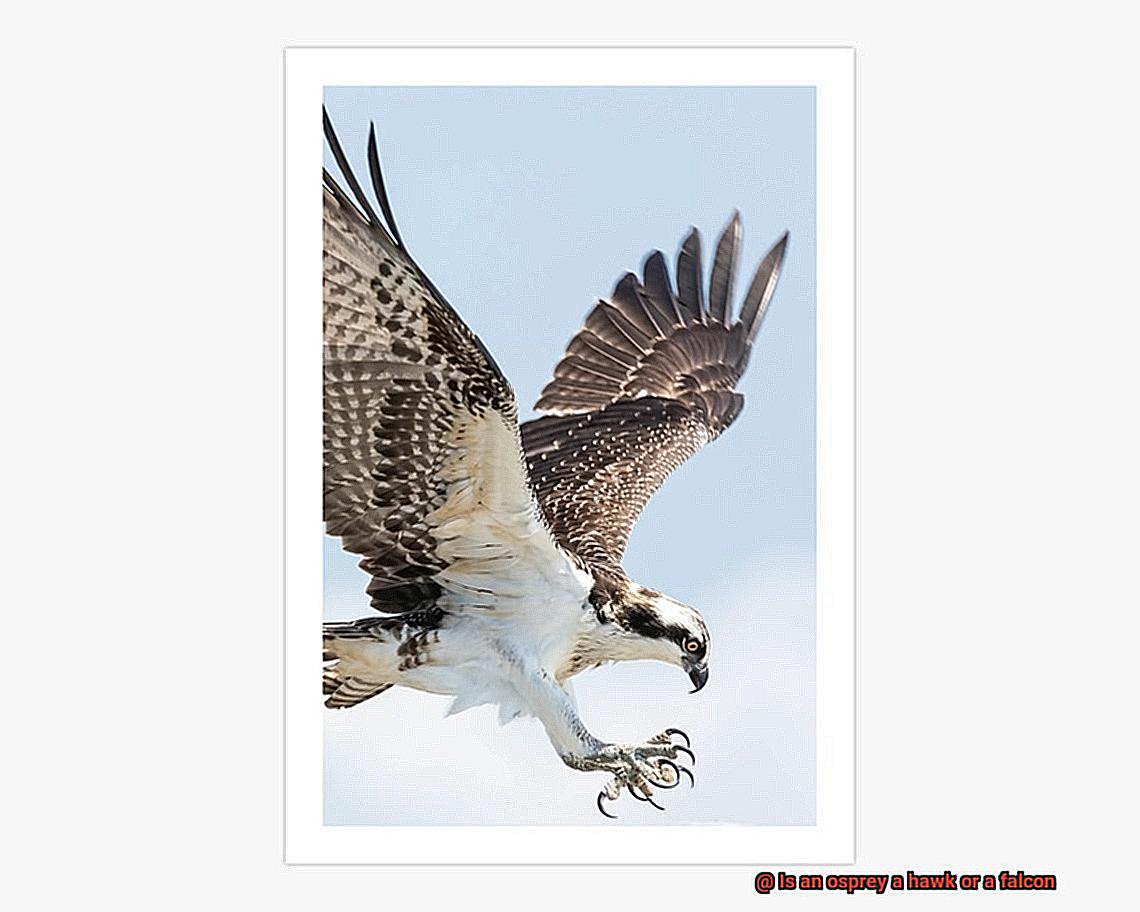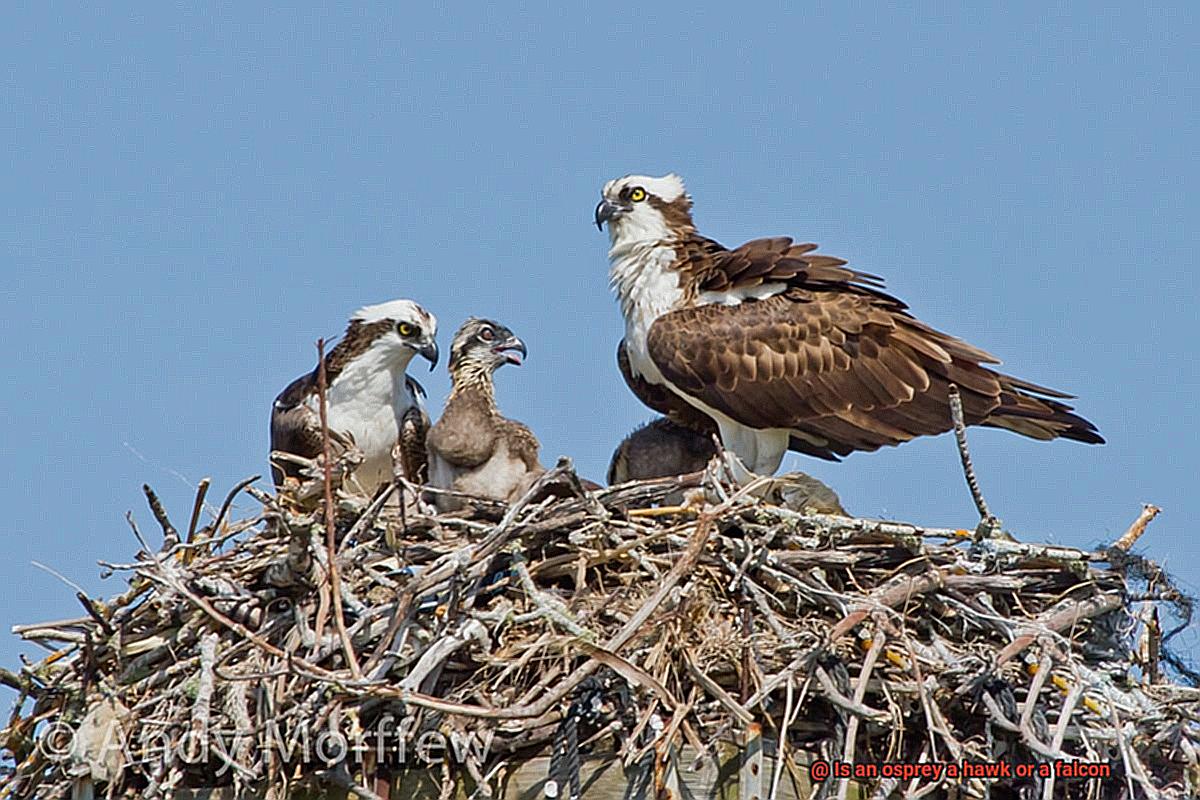
Picture this: the sky is your playground, and you’re soaring alongside magnificent birds of prey. Majestic and captivating, they leave us in awe and itching to know more. But there’s one bird that has even the most seasoned bird watchers scratching their heads – the osprey. Is it a hawk? A falcon? Or something entirely different?
Well, my fellow bird enthusiasts, get ready to embark on an exhilarating journey as we uncover the truth behind this puzzling raptor. We’ll dive into the world of these feathered wonders, blending expert knowledge with a laid-back approach to finally shed light on whether the osprey belongs with hawks, falcons, or if it’s a creature yet to be fully understood.
So buckle up, folks. We’re about to spread our wings and explore the captivating nature of these marvelous birds while we ponder that age-old question: Is an osprey a hawk or a falcon?
Is an osprey a hawk or a falcon
Contents
- 1 Is an osprey a hawk or a falcon
- 2 Physical Characteristics of Ospreys
- 3 Distinguishing Features of Ospreys
- 4 Hawks vs Falcons: What are the Differences?
- 5 Comparing the Hunting Habits of Hawks, Falcons, and Ospreys
- 6 The Unique Plumage of the Osprey
- 7 Special Adaptations for Fishing in Ospreys
- 8 Size Comparison between Hawks, Falcons, and Ospreys
- 9 Conclusion
Birds of prey, such as hawks and falcons, capture our imagination with their soaring flights and impressive hunting skills. However, one bird that often gets mistaken for a hawk or a falcon is the osprey. In this blog post, we will explore the fascinating world of ospreys and compare their characteristics to those of hawks and falcons. By the end, you’ll have a clear understanding of why an osprey is neither a hawk nor a falcon but a unique species in its own right.
Appearance:
Ospreys have distinct features that set them apart from hawks and falcons. Their plumage consists of brown upperparts, white underparts, and a dark eye stripe. This coloring helps them blend in with their surroundings near bodies of water, where they spend most of their time hunting for fish. In contrast, hawks come in various species with different plumage colors, while falcons have sleek bodies and long pointed wings.
Hunting Techniques:
Ospreys are exceptional fishers and have evolved specialized hunting techniques. They soar above the water’s surface, scanning for fish below. Once they spot their prey, they hover momentarily before diving feet-first into the water to catch it with their sharp talons. Hawks, on the other hand, rely on their keen eyesight and agility to hunt small mammals, birds, or reptiles. Falcons are known for their incredible speed and engage in high-speed pursuits, diving at impressive speeds to capture their prey mid-air.
Preferred Habitat:
Ospreys prefer habitats near bodies of water such as rivers, lakes, and coastlines. They build large nests on trees, cliffs, or man-made structures close to the water’s edge. Hawks are adaptable and can be found in various habitats including forests, grasslands, deserts, and even urban areas. Falcons exhibit a wide range of habitats as well, including open country, mountains, and coastal areas.
Specialized Adaptations:
Ospreys have unique adaptations that aid in their fishing prowess. Their nostrils can close to prevent water intake during dives, and they have rough pads on their feet to improve grip while handling fish. Hawks and falcons do not possess these specific adaptations as they rely on different hunting techniques.
Physical Characteristics of Ospreys
Ospreys, also known as fish hawks, are fascinating creatures with a set of physical characteristics that make them exceptional hunters of fish. Let’s explore these distinctive traits and understand what sets them apart from other birds of prey.
Size and Wingspan:
Ospreys are large birds, measuring around 21-24 inches in length, with a wingspan of approximately 5-6 feet. Females are slightly bigger than males, weighing around 3-4 pounds, while males typically weigh about 2-3 pounds. Their impressive size and wingspan enable them to soar high above bodies of water, scanning for their next meal.
One of the most notable physical characteristics of ospreys is their white underparts and dark brown upperparts. This coloration provides effective camouflage while perched or flying over water, making it easier for them to approach unsuspecting fish.
Beak and Eyesight:
Ospreys possess a powerful hooked beak that enables them to tear apart their prey. Their eyes are bright yellow and have a keen vision, capable of spotting fish underwater from heights of up to 130 feet. This remarkable eyesight allows them to pinpoint their target with precision.
Reversible Outer Toe:
A unique adaptation of ospreys is their reversible outer toe. This characteristic allows them to grip their prey firmly with two toes in front and two toes in the back. The ability to grasp fish securely helps ensure a successful catch even when the slippery prey tries to escape.
Feet and Talons:

Unlike hawks and falcons, ospreys have specialized feet equipped with spiky scales that prevent fish from slipping out of their grasp. Additionally, they possess long, curved talons that aid in securing the catch while in flight. These adaptations make ospreys highly efficient hunters, particularly when it comes to snatching fish from the water’s surface.
Wing Shape and Flight:
Ospreys have long, narrow wings that allow them to soar effortlessly in the air. Their wings are uniquely designed for efficient flight and hovering above water before diving in for a catch. With their exceptional flying skills, ospreys can reach speeds of up to 50 miles per hour during migration.
Plumage:
Ospreys undergo a molt every year after breeding season. This molting process ensures that they have fresh new feathers, maintaining their flight capabilities. The plumage of ospreys is a stunning sight to behold, with its distinct blend of white and brown feathers.
Vocalization:
Lastly, ospreys have a distinct call that can be described as a high-pitched chirp or whistle. This vocalization serves various purposes, including communication between mates and offspring, as well as territorial defense.
Distinguishing Features of Ospreys
Today, we dive into the world of ospreys, magnificent creatures that reign over the waters as skilled fish hawks. Ospreys possess a set of distinguishing features that set them apart from their avian counterparts – hawks and falcons. Let’s explore these unique attributes that make ospreys truly remarkable.
Size Does Matter:
Ospreys are larger than most hawks and falcons, flaunting a wingspan of up to 6 feet. This impressive size makes them instantly recognizable and distinguishes them from their smaller relatives.
Fashionable Plumage:
With a predominantly brown and white coloration, ospreys sport a striking pattern. Dark brown markings adorn their upperparts, while a pristine white underbelly catches the eye. This distinct plumage sets them apart from the varying color combinations and patterns seen in hawks and falcons.
Feet Fit for Fishing:
Now, let’s talk about osprey feet – a feature that showcases their unrivaled fishing prowess. Their specially designed feet boast long, curved talons and reversible outer toes. These adaptations enable ospreys to grip slippery fish with ease, a characteristic absent in the foot structures of hawks and falcons.
Wings That Bend:
Take a closer look at an osprey’s wings, and you’ll notice a unique bend at the wrist joint – a “crook,” if you will. This crook allows ospreys to adjust their wing angles during flight, enhancing maneuverability and facilitating their impressive dives into water. Hawks and falcons possess different wing shapes tailored to their respective hunting techniques.
Plunging From Heights:
Picture this: an osprey soaring high above the water, keenly observing its prey below. In an instant, it plunges headfirst into the water, talons outstretched, capturing its elusive target. This remarkable hunting behavior – known as “plunging” or “stooping” – is exclusive to ospreys. Hawks and falcons employ different hunting techniques, making this behavior a key distinguishing feature of ospreys.
Coastal Connoisseurs:
Ospreys have a distinct preference for coastal areas and freshwater habitats near lakes, rivers, and estuaries. They build their nests on tree limbs or man-made structures close to the water, ensuring easy access to their primary food source – fish. In contrast, hawks and falcons are more adaptable to various habitats.
Hawks vs Falcons: What are the Differences?
When it comes to birds of prey, hawks and falcons are two of the most fascinating species. While they may share some similarities in their hunting skills and sharp vision, there are several key differences that set them apart. So, let’s dive into the details and explore the contrasting characteristics of hawks and falcons.
Size Matters
Size is one of the most noticeable differences between hawks and falcons. Hawks, with their imposing presence, tend to be larger than falcons. Some hawk species can reach up to 30 inches in length, while falcons usually measure around 15-20 inches long. It’s like comparing a linebacker to a speedy wide receiver.
Body Shape: Wings for Soaring or Speed?
Hawks and falcons also have distinct body shapes that match their hunting techniques. Hawks possess broad wings and a wide tail, which allows them to soar effortlessly in the air for extended periods. On the other hand, falcons sport more pointed wings and a narrow tail, enabling them to achieve incredible speeds during their hunting dives. It’s like comparing a glider to a race car.

Habitat Preference: Urban or Open Spaces?
In terms of habitat preference, hawks and falcons have different preferences. Hawks are adaptable creatures that can be found in various environments such as forests, grasslands, and even urban areas. They build nests on trees or cliffs and often stay in one area for an extended period. Falcons, however, prefer open spaces like deserts, prairies, and coastal regions. They tend to nest on tall structures such as cliffs or buildings and are more migratory than their hawk counterparts.
Diet: Versatility vs Bird Buffet
When it comes to dining habits, hawks are versatile hunters that enjoy a wide variety of prey including rodents, birds, reptiles, and even insects. They’re like the gourmands of the bird world, always ready for a feast. Falcons, on the other hand, have a more refined palate and primarily feed on other birds, especially smaller species that they can catch in mid-air. It’s like comparing a buffet lover to a connoisseur.
Behavior: Patience vs Constant Motion
In terms of behavior, hawks and falcons exhibit distinct characteristics. Hawks are patient hunters that spend a significant amount of time perched or soaring in search of food. They’re the Zen masters of the bird world, waiting for the perfect moment to strike. Falcons, on the other hand, are more active hunters and tend to be constantly on the move, always looking for their next target. They’re like the Energizer bunnies of the sky.
Comparing the Hunting Habits of Hawks, Falcons, and Ospreys
Hawks, falcons, and ospreys are all incredible birds of prey that have evolved unique hunting strategies to survive in their respective habitats. In this section, we will delve into the fascinating world of these magnificent creatures and explore how they differ in their hunting habits.
Hawks: The Mighty Predators
Hawks are known for their keen eyesight and exceptional agility in flight. They prefer to perch on high vantage points or soar through the skies, using their sharp vision to locate potential prey. Once they spot a target, hawks will swoop down with lightning-fast speed and accuracy to catch their meal.
Their diet consists of small to medium-sized animals such as rodents, snakes, and even other birds. Hawks have strong talons that they use to grasp and immobilize their prey before devouring it.
Falcons: The Speed Demons
Falcons have a distinct hunting style that sets them apart from hawks. These magnificent birds are renowned for their incredible speed and aerial acrobatics. With their long, pointed wings, falcons can achieve astonishing speeds while in flight.
They often engage in high-speed pursuits called stoops, where they dive steeply towards their prey from great heights. This allows them to deliver a swift and lethal blow to their target. Falcons primarily feed on smaller birds and insects, using their sharp beaks to strike with precision.
Ospreys: The Fish Hunters
Unlike hawks and falcons, ospreys have adapted specifically to hunt fish. They possess unique physical characteristics that enable them to excel in aquatic environments. Ospreys have long, curved talons designed for gripping slippery prey like fish. Their reversible outer toes allow them to maintain a firm grip while flying. Ospreys are skilled at hovering above bodies of water, scanning for fish below.
Once they spot a potential meal, they plunge feet-first into the water, catching their prey with great accuracy. To minimize drag during flight, ospreys orient their catch headfirst, ensuring efficient transportation back to their nests.
The Unique Plumage of the Osprey
When it comes to fish-eating raptors, the osprey reigns supreme. Its unique plumage plays a crucial role in its success as a hunter near bodies of water. Let’s dive into the fascinating world of the osprey’s feathers and explore how they contribute to its remarkable hunting skills.
Blending In: The Art of Camouflage
Ospreys have a distinctive plumage that helps them blend seamlessly with their surroundings. Their predominantly brown upper body provides excellent camouflage against the earthy tones of trees and rocks.
On the other hand, their contrasting white underside helps them remain inconspicuous when soaring above the water, waiting for the perfect opportunity to strike.
The Malar Stripe: A Striking Feature
One cannot help but notice the osprey’s dark eye stripe, also known as a “malar stripe.” This unique marking extends from the base of its beak to its eye, giving the osprey an unmistakable appearance. While the exact purpose of this feature is still debated among experts, it is believed to help reduce glare and improve visual acuity, allowing the osprey to spot fish more easily even in bright sunlight.
Wings of Precision and Grace
A key adaptation of the osprey’s plumage lies in its long, narrow wings. These wings are perfectly designed for soaring and provide exceptional maneuverability during flight. Additionally, the osprey’s wings feature a distinct pattern of dark and light patches. The dark patches on the upper side of the wings help break up its silhouette, making it less visible to potential prey from below.
Specialized Feet for Slippery Prey
Unlike their counterparts in the hawk and falcon families, ospreys have specialized scales on their feet called “spicules.” These spicules provide extra grip when catching slippery fish, ensuring that their prey doesn’t slip away. In addition, ospreys possess reversible outer toes that enable them to grasp and carry their catch more effectively. This adaptation is particularly crucial when capturing fish from the water’s surface.
Size Matters: Finding the Perfect Balance
Ospreys fall somewhere between hawks and falcons in terms of size. They typically have a wingspan of around five to six feet and weigh between three to four pounds. This size allows them to maneuver with agility while still possessing the strength to capture and carry fish back to their nests.
Special Adaptations for Fishing in Ospreys
Ospreys, also known as fish hawks, are truly remarkable birds with specialized adaptations that make them exceptional hunters of fish. Let’s dive into the fascinating world of osprey adaptations for fishing and explore what sets them apart from other raptors.
Sharp Talons and Reversible Feet
Ospreys have feet that are a force to be reckoned with. Their sharp, curved talons and spines on the soles give them a vice-like grip on slippery fish. But here’s the kicker – their talons are reversible. They can rotate them to get an even stronger hold on their catch. Talk about having the upper hand in a fishy battle.
Broad Wings for Soaring and Hovering
These magnificent birds have wings that are built for success in the hunt. Ospreys boast long, broad wings that allow them to soar effortlessly above the water, scanning for prey. But the real magic happens when they spot a fish. They can hover in mid-air, like a helicopter, using their powerful wings to keep them steady while they plan their attack. It’s like watching a stealthy warrior plotting its next move.
The Plunge of Precision
Once an osprey spots a fish near the water’s surface, it’s time for action. With wings folded, they dive headfirst into the water, extending their feet forward like an Olympic diver reaching for gold. This precise maneuver is made possible by their strong wings and powerful muscles, enabling them to snatch their slippery meal with pinpoint accuracy. It’s a sight to behold.
Eagle Eyes on the Prize
Ospreys have eyesight that would make any aspiring fisherman green with envy. Their eyes are equipped with a high density of photoreceptor cells, which allows them to see clearly both above and below the water’s surface. This superpower enables them to spot fish from great heights and accurately dive in for the catch. Talk about having eyes like a hawk – or in this case, an osprey.
Carrying with Ease
Ever wondered how ospreys manage to fly effortlessly with a heavy fish in their talons? It’s all thanks to their unique ability to adjust the position of their outermost toe. By carrying their catch parallel to their body, ospreys reduce drag and fly more efficiently. It’s like they’ve got the secret recipe for success in the skies.
While ospreys are renowned for their fishing prowess, they are not limited to a seafood diet. These opportunistic hunters may occasionally snack on small mammals or birds if fish are scarce in their environment. It’s all about adaptation, my friends.
Size Comparison between Hawks, Falcons, and Ospreys
When it comes to size, hawks, falcons, and ospreys each have their own distinct characteristics. Let’s take a closer look at the size comparison between these birds of prey.
Hawks:
Hawks are medium-sized raptors with a body length ranging from 16 to 24 inches (40 to 60 cm) and a wingspan of about 3 to 4 feet (0.9 to 1.2 meters). Some common hawk species include the red-tailed hawk, Cooper’s hawk, and sharp-shinned hawk. They typically weigh between 1 to 3 pounds (0.4 to 1.4 kg).
Falcons:
Falcons are known for their exceptional speed and agility in flight. They are generally smaller than hawks, with an average body length of 12 to 20 inches (30 to 50 cm) and a wingspan ranging from 2.5 to 3 feet (0.7 to 0.9 meters). Peregrine falcons, American kestrels, and merlins are among the well-known falcon species. Falcons are lighter than hawks, weighing around 0.5 to 2 pounds (0.2 to 0.9 kg).
Ospreys:
Ospreys have unique physical characteristics that set them apart from hawks and falcons. They are large raptors with a body length ranging from 21 to 24 inches (53 to 61 cm) and a wingspan of approximately 5 to 6 feet (1.5 to 1.8 meters). Ospreys have long, narrow wings and distinctive white chests with brown speckles. They weigh between 3 to 4.5 pounds (1.4 to 2 kg) on average.
It’s important to note that these size ranges are generalizations and can vary depending on the specific species within each group. For example, some hawk species may be smaller or larger than the average size mentioned above. Additionally, there can be variations in size between males and females within a species.
The size differences between hawks, falcons, and ospreys are influenced by various factors, including their hunting strategies, habitat preferences, and prey availability. Hawks and falcons tend to be more agile and adept at pursuing smaller prey in open areas, while ospreys have adapted to hunting fish near bodies of water.
Conclusion
In conclusion, the osprey is neither a hawk nor a falcon.
It stands apart as a unique and remarkable bird of prey. With its distinctive appearance and specialized hunting techniques, the osprey captivates observers worldwide.
Its powerful wingspan, sharp talons, and keen eyesight make it an apex predator in aquatic environments. Unlike hawks and falcons, the osprey has adapted to a diet primarily consisting of fish.
Its incredible ability to dive into water and snatch its prey with precision is a sight to behold.


